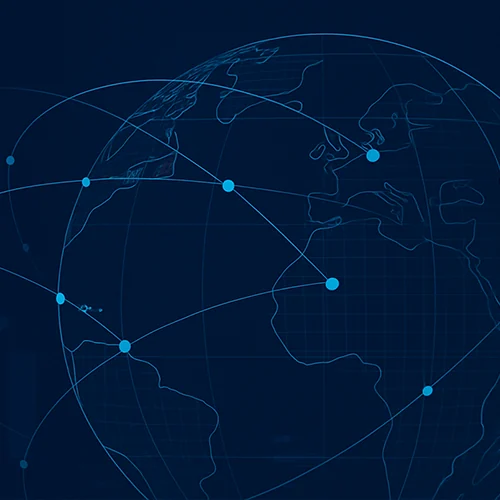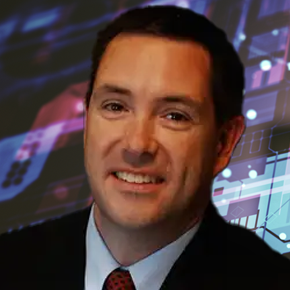October 24, 2024
Is The Promise of Industry 4.0 Too Good to Be True?

Transcript
We talk about technology adoption within the manufacturing industry as if it’s a magic elixir. With the right digitization effort and the right insights platform, we say that manufacturers can lower their cost, decrease design errors, speed time to market, maybe even get CO2 under control.
But is that true? Or is it all too good to be true?
My guest today helps manufacturers throughout Europe, the Middle East, Africa, and India through their digitization efforts and realizing the promise of Industry 4.o. Paul Haimes is the VP of EMEAI Solutions Consulting at PTC. And he’s here today to talk to us about the promises of Industry 4.0 and whether or not they really are too good to be true. Paul Haimes, welcome to the podcast.
Paul Haimes: Thanks, Leah.
What Problems Does Industry 4.0 Solve?
Leah Archibald: So let’s start with these big-picture problems:
- Lowering manufacturing cost
- Decreasing manufacturability errors
- Speeding time to market
- Tracking Sustainability
Are these the questions that manufacturers are facing, and is this what they’re trying to accomplish when they come to you?
Paul Haimes: It is. Many of our customers today are still on that journey around digital transformation. Within engineering, companies are trying to grapple with increasing product complexity –things like variant management, for example. And then we have manufacturing and everything that’s going on in the factory from a sustainability standpoint. But we’ve also seen the effects of managing supply chain issues, which first began with COVID. And then we have service, this whole idea of the connected product being out there with your consumers. For all these reasons, we see companies moving away from homegrown solutions which they may be now struggling to scale. And now they want to move towards industry platforms that really take some of that headache away from them.
Leah Archibald: It sounds like you just laid out several different problems that manufacturers are facing. Within Industry 4.0, is there one solution to each problem? Or is there one magic bullet solution that you’re proposing?
Paul Haimes: I think there is. The great thing about digital transformation is that whether you’re starting with use cases in the factory, or you’re starting with use cases in engineering or a combination, digital transformation has the ability to impact and add value in many areas across the business. What I think is critical is that you have a plan, that you don’t just sort of set off trying to achieve one thing. What you need is a strategy and a roadmap that’s going to allow you to deliver value right the way through the business for the next five to 10 years as you deploy more and more use cases.
Leah Archibald: You’re saying, “First let’s come up with a list of problems. I don’t want a solution looking for a problem. I want to hear what your problems are. And then let’s come up with near-term, medium-term, and long-term areas that you want to focus on.” Because if getting time to market is really the pain point at number one, you’re going to focus on that first, versus someone who’s coming to you because they all of a sudden need to track carbon because of new regulations. So, it might be a similar digitization solution or digitization plan, but focusing on different areas to get the ROI where the business is hurting first is going to be important for the wins for that particular manufacturer; have I got it right?
Paul Haimes: You have. You use the word ROI, that return on investment, that focus on value is, I believe, the most important thing. Everything is going to be linked back to what the company is trying to achieve. And you flow down from there and you’ll find that all of the use cases, the dozens and dozens and dozens of use cases, if you put value at the very heart of what you’re trying to do for your customer, you will find that those use cases become clustered and therefore achievable in a roadmap.
PTC and aPriori Deliver Value
Leah Archibald: When you’re going in and setting up a solution with one of your customers, how does the PTC platform and aPriori work together?
Paul Haimes: I think where our touch points are perhaps most valuable for our customers is around sustainability and around cost management and taking cost out of the product. Now on the sustainability topic, we never get a request for proposal or any engagement with a customer that now doesn’t include some element of, “How can your technology help us achieve our sustainability goals from scope one, scope two and scope three?” And so for us, the combination of aPriori’s capabilities linked with our CAD and PLM technologies makes a hugely powerful set of tools, giving an engineer the ability to understand, given that 80% of that carbon debt is baked in at the design phase for a lot of components, irrespective of industry, given that that decision process for the engineer is so fundamental to the carbon footprint that the product will have, giving them the tools at the point of use to make informed decisions about these materials versus this other material.
If you think about rolling up that overall carbon debt that a product has, that is a function within the PLM system. Understanding the lifecycle analysis, the LCA of a particular product, are hugely important things where the combination of PTC and aPriori give customers some fantastic capabilities in that area together. This is critical when looking at this notion of the model-based enterprise now, whereby we are trying to capture as much information as we can within that digital thread environment, so that we have information around the material quality and its carbon debt, the dimensional criticality that we have to ensure we get the quality we require, the manufacturing information, the tolerances that we’re going to be machining to, even things like service information, we just want a simple app that’s gonna allow us to see what we need to see when we need to see it.
Understanding all of that requires a huge integration of the enabling technologies and the offering tools that have this information. And we need to get it to the surface so that it can then be made use of throughout the business.
Is Industry 4.0 Delivering on its Promises?
Leah Archibald: Even in that explanation of, “This is how we make this simpler to create a model-based enterprise,” there are a lot of different moving parts here. So, for a while I was on track with, “Yes, the promises of industry 4.0 are there.” But now I’m wondering, “Is it too good to be true?” You tell me where you come down on this issue. Are we delivering on the promise or is it too good to be true?
Paul Haimes: No, we are delivering. We are delivering. The technology is proven, as I mentioned, it is now deployable. We’re very confident and comfortable deploying digital transformation use cases in our customers, whether, like I said, it starts in engineering, in manufacturing, or in that connected product and service arena.
I think what we do see is layered on top of this: the pace of change today is huge. That complexity of the software-driven product adds yet another layer, another axis of difficulty for manufacturers. So how do you integrate those two processes so that you’ve got control of all of your product development? We’re working through those challenges. And then that learning, that knowledge, then flows into our other customers that are also needing to meet these problems head-on, but perhaps don’t have the scale that some of the bigger ones do.
Leah Archibald: Paul Haimes, thank you so much for talking to us on the podcast today.
Paul Haimes: It’s been a pleasure. Thanks for having me.








